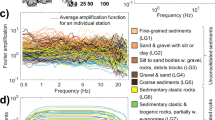Abstract
The site amplifications for three stations, Libin (LIBI), Baisha (BASH) and Yulong (YULG) situated respectively in the southern, middle and northern parts of Lijiang Valley, are obtained by analyzing the S-wave soil/bedrock and microtremor horizontal/vertical spectral ratios. The data are digital recordings for the aftershocks of the Lijiang M s=7.0 earthquake on February 3, 1996. In the frequency range of 1–4 Hz, the S-wave soil/bedrock spectral ratio of E-W component for LIBI is the largest and amounts to 4.5. The microtremor soil N-S/vertical (V) spectral ratio is approximate to 1, E-W/V is about 4.5 and the same with above soil/bedrock spectral ratio. It is shown that the vertical and N-S components of microtremor have not been amplified by the soil and the Nakamura’s method is applicable. With this method, the microtremor spectral ratios for BASH and YULG are further evaluated. They have similar characteristics with that of LIBI. In above frequency range, both N-S/V ratios are approximate to 1, while the E-W/V ratio is about 6 for BASH, 4.5 for YULG. Lijiang Valley is characterized by the trans-valley directional site response.
Similar content being viewed by others
References
Aki K, Chouet B. 1975. Origin of coda waves: source, attenuation and scattering effects. J Geophys Res, 80(23): 3 322–3 342
Borcherdt R D. 1970. Effects of local geology on ground motion near San Francisco Bay. Bull Seism Soc Amer, 60)1): 29–61
Dravinski M, Ding G, Wen G L. 1996. Analysis of spectral ratios for estimating ground motion in deep basins, Bull Seism Soc Amer, 86(3): 646–654
Field E H, Clement A C, Jacob K H, et al. 1995. Earthquake site response study in Guimri (formerly Leninakan), Armenia, using ambient noise observations. Bull Seism Soc Amer, 85(1): 349–353
Kagami H, Duke C M, Liang G C, et al. 1982. Observation of 1 to 5 second microtremors and their application to earthquake engineering. Part II. Evaluation of site effect upon seismic wave amplification due to extremely deep soil deposits. Bull Seism Soc Amer, 72(3): 987–998
Lermo J, Chavez-Garcia F J. 1994. Are microtremors useful to site response evaluation? Bull Seism Soc Amer, 84(4): 1 350–1 364
Luo D H, Ye J Q, Chen M G, et al. 1997. Study on the source parameters of the aftershocks for the M=7.0 Lijiang earthquake. Journal of Seismological Research, 20(1): 62–91 (in Chinese)
Nakamura Y. 1989. A method for dynamic characteristics estimation of subsurface using microtremors on the ground surface. Quart Rept Railway Tech Res, 30(1): 25–33
Singh S K, Mena E. 1988. Some aspects of source characteristics of the 19 September 1985 Michoacan earthquake and ground motion amplification in and near Mexico City. Bull Seism Soc Amer, 78(2): 451–477
Zhou G Q, Zhang J G, Zhou R Q, et al. 1997. Analysis on seismological tectonic background of the M=7.0 Lijiang earthquake. Journal of Seismological Research, 20(1): 92–100 (in Chinese)
Author information
Authors and Affiliations
Additional information
This research belongs to the “Ninth-Five Subject” (95-04-05-02-02) of China Seismological Bureau.
About this article
Cite this article
Li, BJ., Qin, JZ., Luo, DH. et al. Site amplification in the Lijiang Valley, Yunnan Province. Acta Seimol. Sin. 12, 193–198 (1999). https://doi.org/10.1007/s11589-999-0024-3
Received:
Revised:
Accepted:
Issue Date:
DOI: https://doi.org/10.1007/s11589-999-0024-3




